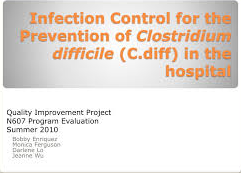Final Research Project Assignment on Clostridium Difficile Title Page and reference page required. Final Research Project Assignment Information

Select a topic from the list and write your paper discussing the selected disease using the guidelines and rubric below.
List of Suggested Subjects
Bacterial Diseases
- Chlamydia (STD)
- Cholera
- Clostridium difficile
- Diphtheria
- E coli 0157:H7
- Gonorrhea
- Group A Strep
- Group B Strep
- Hansen’s disease
- Legionnaire’s disease
- Leptospirosis
- Listeriosis
- Lyme disease
- Meningococcal meningitis
- MRSA
- Nocardiosis
- Pertussis
- The Black Plague
- Streptococcus pneumoniae
- Puerperal fever
- Q Fever
- Rocky Mountain Spotted Fever
- Salmonellosis
- Shigellosis
- Syphilis
- Toxic Shock Syndrome
- Tuberculosis
- Tularemia
- Typhus
- VRE
Final Research Project Assignment on Clostridium Difficile Viral Diseases
- AIDS
- Arboviral Encephalitis
- Dengue Fever
- Ebola
- Hantavirus pulmonary syndrome
- Hepatitis A
- Hepatitis B
- Hepatitis C
- Herpes simplex
- HPV
- Influenza
- Lassa fever
- Norovirus
- Polio
- Rabies
- Respiratory Syncytial Virus
- Rotavirus
- Rubella
- Rubeola
- Smallpox
- West Nile Virus
- Yellow Fever
- Creutzfeldt-Jacob Chronic Wasting Disease
- Prion Disease
Final Research Project Assignment on Clostridium Difficile Guidelines
The paper should be a minimum of 5 pages of relevant and informative material that covers all of the content and requirements listed below and in the rubric. The 5 pages do not include the title and reference pages. The paper should thoroughly inform the reader.
APA format. This includes citations and references
Title page must have a title (name of the disease selected), student name, instructor name, course title, and date.
No direct quotes; put information into your own words or paraphrase
Minimum of five reliable internet references, plus any other references used. You also must include in-text citations.
1 inch margins
Double-spaced
12 point, Times New Roman
After uploading to Turnitin, your paper will be scored for similarity. Anything above 20% similarity should be worked on further and uploaded again before the due date. Please email your instructor for more help with this.
Over 20% similarity and/or no references will result in an automatic zero on the paper.
The paper should contain the following information:
- What is the causative agent of the disease? Is it a bacterium, a virus, a prison, or a eukaryote?
- If it is a bacterium, what are the characteristics of the cell (Gram-reaction, cell shape and arrangement? metabolic capabilities?).
- If it is a virus, what are its characteristics (DNA, positive-strand RNA, negative-strand RNA, or retrovirus? enveloped or naked? how large is it? does it form a provirus? Any unique characteristics of its multiplication cycle?).
- If it is a prison, what is a prison? Wherein the body does it occur? What is the function of the normal-type protein?
- If it is a eukaryote, is it a fungus, an alga, a protozoan, a platyhelminth, or a nematode? Is it multicellular or unicellular? What is its life cycle?
- History: How long have we known about this disease?
- Describe the changes in our knowledge and attitudes toward this disease throughout history.
- Epidemiology: Describe the prevalence and transmission of this disease.
- Where (in the world) is the disease prevalent? How many people are currently infected? What is the rate of new infections? What are the rates of morbidity and mortality?
- What is (are) the reservoir(s) of the pathogen? What is (are) the mode(s) of transmission?
- Pathology: Describe the pathogenic effects on cells, tissues, and organ systems.
- Where in the body (what tissues/organs/cells) does the pathogen affect?
- What damage does the pathogen inflict? How is this damage inflicted (is there direct mechanical damage? is it a toxin produced? does the immune response cause damage?)?
- What is the time sequence of the disease (length of incubation, prodrome, illness, decline, and convalescence)?
- What are the major signs and symptoms?
- Response and Treatment
- Describe the activity of our immune system against the pathogen.
- What types of medical treatments exist? Describe how these treatments affect the progression of the disease.
- Describe prophylactic measures that can be taken to limit the risk of infection.
- Socio-politico-economic
- Describe any historic or present-day social, economic, or political issues that either help or hinder us in limiting the spread of the disease.
- Suggest policies and practices that can be employed to help with limiting the spread of the disease. For each policy and practice, describe what will be needed (what we have to sacrifice) in order to properly implement the proposal.
Grading rubric for the written report:
Disease Causative Agent
10 points
History
15 points
Epidemiology
10 points
Pathology
10 points
Response and Treatment
15 points
Socio-Politico-Economic
5 points
References
10 points
5 Page Minimum
15 points
Academic Writing and Format
10 points
TOTAL
100 points




